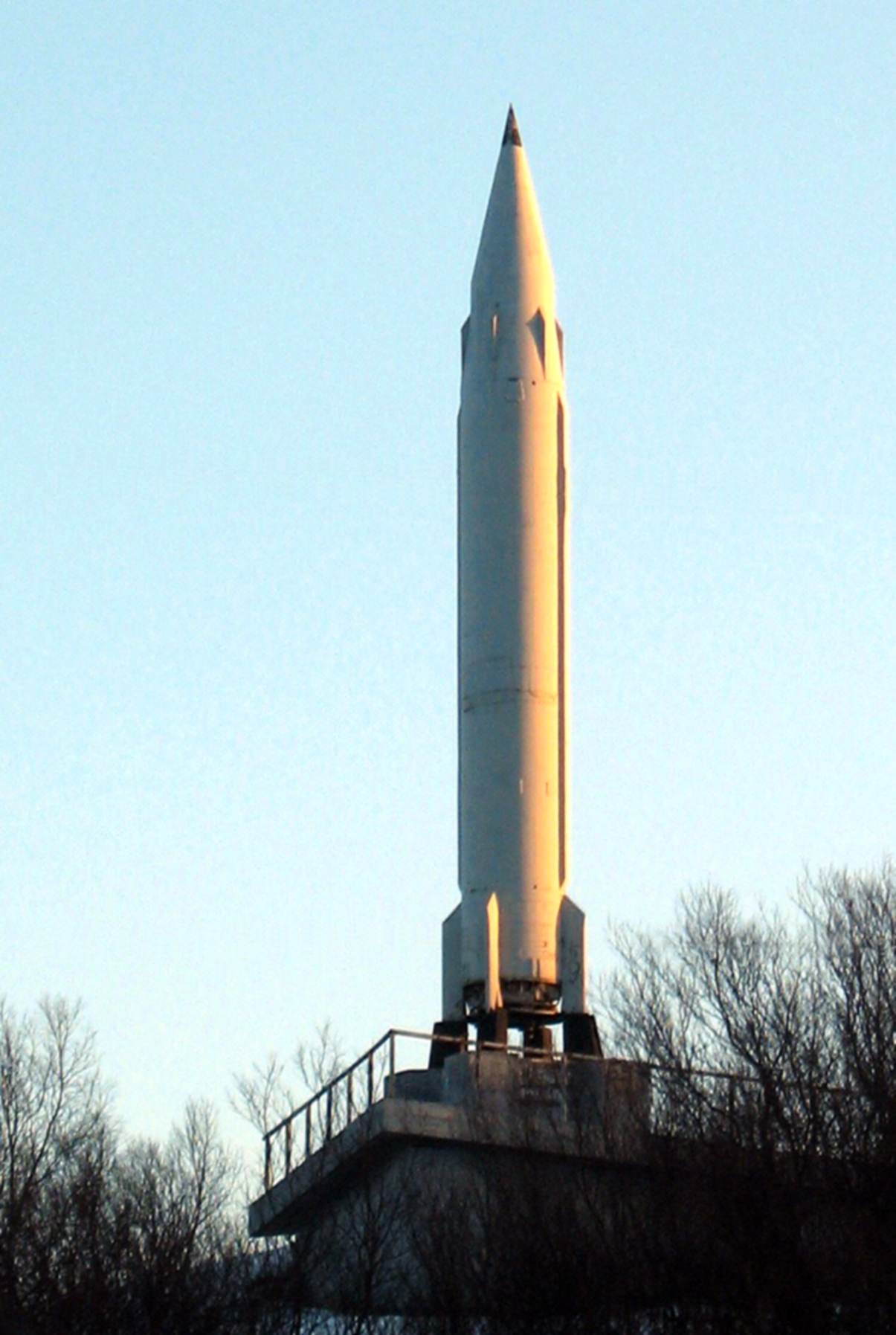R-13 (missile) on:
[Wikipedia]
[Google]
[Amazon]
 The R-13 (russian: ракета-13) was a
The R-13 (russian: ракета-13) was a
FAS.org: R-13 / SS-N-4 SarkРакетный комплекс Д-2 С БРПЛ Р-13(35-М-4)
In Russian - inc diagrams {{Russian and Soviet missiles, SSM R-013 Cold War missiles of the Soviet Union Makeyev Rocket Design Bureau Military equipment introduced in the 1960s
 The R-13 (russian: ракета-13) was a
The R-13 (russian: ракета-13) was a submarine-launched ballistic missile
A submarine-launched ballistic missile (SLBM) is a ballistic missile capable of being launched from submarines. Modern variants usually deliver multiple independently targetable reentry vehicles (MIRVs), each of which carries a nuclear warhead ...
(SLBM) developed by the Soviet Union
The Soviet Union,. officially the Union of Soviet Socialist Republics. (USSR),. was a transcontinental country that spanned much of Eurasia from 1922 to 1991. A flagship communist state, it was nominally a federal union of fifteen nationa ...
starting around 1955. It was assigned the NATO reporting name
NATO reporting names are code names for military equipment from Russia, China, and historically, the Eastern Bloc (Soviet Union and other nations of the Warsaw Pact). They provide unambiguous and easily understood English words in a uniform man ...
SS-N-4 Sark and carried the GRAU
The Main Missile and Artillery Directorate of the Ministry of Defense of the Russian Federation (), commonly referred to by its transliterated Russian acronym GRAU (), is a department of the Russian Ministry of Defense. It is subordinate to the ...
index 4K50.
History
Development of the R-13 was authorised by the Soviet Supreme Council on 25 July 1955 for use on the Project 629 and Project 658 submarines. The design work was started byOKB-1
PAO S. P. Korolev Rocket and Space Corporation Energia (russian: Ракетно-космическая корпорация «Энергия» им. С. П. Королёва, Raketno-kosmicheskaya korporatsiya "Energiya" im. S. P. Korolyov ...
under Sergei Korolev
Sergei Pavlovich Korolev (russian: Сергей Павлович Королёв, Sergey Pavlovich Korolyov, sʲɪrˈɡʲej ˈpavləvʲɪtɕ kərɐˈlʲɵf, Ru-Sergei Pavlovich Korolev.ogg; ukr, Сергій Павлович Корольов, ...
before being transferred to CB Miasskoe engineering / Makeyev Rocket Design Bureau
The JSC Makeyev Design Bureau (russian: ГРЦ Макеева; also known as Makeyev OKB) is a Russian missile design company located in Miass, Russia.
Established in December 1947 as SKB-385 in Zlatoust (see Zlatoust Machine-Building Plant), ...
(chief designer - Viktor Makeyev). Final technical specifications was approved by 11 January 1956. Serial production was undertaken at Zlatoust Machine-Building Plant
The JSC Zlatoust Machine-Building Plant (ZlatMash) is an arms manufacturing plant in Zlatoust, Chelyabinsk Oblast, Russia. It produced many of the Soviet Union's nuclear weapons, including the R-39 Submarine-launched ballistic missile.
The pla ...
in 1959. The R-13 was a single-stage liquid-fuel rocket
A liquid-propellant rocket or liquid rocket utilizes a rocket engine that uses liquid propellants. Liquids are desirable because they have a reasonably high density and high specific impulse (''I''sp). This allows the volume of the propellant ta ...
and entered service in 1961. This missile was somewhat similar in design to the R-11FM missile, which caused some confusion in Western intelligence service
An intelligence agency is a government agency responsible for the collection, analysis, and exploitation of information in support of law enforcement, national security, military, public safety, and foreign policy objectives.
Means of informatio ...
s during the Cold War
The Cold War is a term commonly used to refer to a period of geopolitical tension between the United States and the Soviet Union and their respective allies, the Western Bloc and the Eastern Bloc. The term '' cold war'' is used because t ...
. The missiles were phased out from 1965 to 1975.
This missile was the first Soviet design to use a small set of rocket engine
A rocket engine uses stored rocket propellants as the reaction mass for forming a high-speed propulsive jet of fluid, usually high-temperature gas. Rocket engines are reaction engines, producing thrust by ejecting mass rearward, in accorda ...
s ( vernier thrusters) to perform course and trajectory alterations instead of aerodynamic
Aerodynamics, from grc, ἀήρ ''aero'' (air) + grc, δυναμική (dynamics), is the study of the motion of air, particularly when affected by a solid object, such as an airplane wing. It involves topics covered in the field of fluid dyn ...
control surfaces, although a set of four stabilizers were used to keep the missile on-course during initial flight.
During initial testing before the missiles were deployed, 26 of 32 missiles (81%) were successfully launched. While the systems were deployed from 1961 to 1975, 225 of 311 launches (72%) were successful.
Operators
; * Soviet NavySpecifications
*Length: 11.8 m (38 ft 9 in) *Diameter: 1.3 m (4 ft 3 in) *Diameter (to stabilizers): 1.9 m (6 ft 3 in) *Launch weight: 13.7 t *Warhead: single thermonuclear: 1.2 to 2.0 Mt (perhaps as low as 1.0 Mt) *Propulsion: liquid-fuel rocket, single stage **Oxidizer: AK-271 **Fuel:TG-02
Tonka (also TONKA-250 and R-Stoff) is the name given to a German-designed rocket propellant first used in the Wasserfall missile, and recently used by North Korea. It was used in the Soviet Union under the name TG-02, for example in the engine desi ...
*Range: about
*Launching technique: surfaced
*CEP
''Boletus edulis'' (English: cep, penny bun, porcino or porcini) is a basidiomycete fungus, and the type species of the genus ''Boletus''. Widely distributed in the Northern Hemisphere across Europe, Asia, and North America, it does not occu ...
: 1.8 to 4 km (1.1 to 2.5 miles)
See also
*List of missiles
Below is a list of missiles, sorted alphabetically into large categories and subcategories by name and purpose.
Other missile lists
Types of missiles:
* Conventional guided missiles
** Air-to-air missile
** Air-to-surface missile
** Anti-rad ...
References
FAS.org: R-13 / SS-N-4 Sark
In Russian - inc diagrams {{Russian and Soviet missiles, SSM R-013 Cold War missiles of the Soviet Union Makeyev Rocket Design Bureau Military equipment introduced in the 1960s